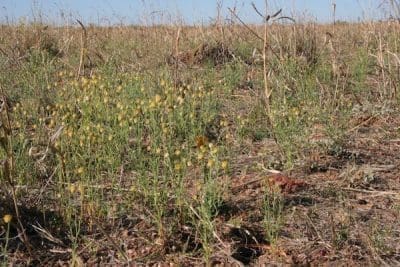Livestock producers in Queensland, New South Wales and South Australia are being warned to be alert to the potential emergence of pimelea as research continues into solutions to treat livestock poisoning from the potentially fatal plants.
The pimelea group of plants are poisonous to grazing animals across much of the three states, causing what’s widely known as St George Disease. Symptoms include chronic diarrhoea, loss of condition, characteristic fluid swelling under the jaw and/or down the neck and brisket, and prominent pulsing jugular vein in the neck.
The problem was highlighted in 2015 and again in 2017 when numerous cattle deaths and production losses occurred in Queensland herds.
Work is ongoing on two linked projects researching pimelea poisoning, funded by Meat & Livestock Australia (MLA) and coordinated by Associate Professor Mary Fletcher of The University of Queensland’s (UQ) Queensland Alliance for Agriculture and Food Innovation (QAAFI).
MLA Project Manager – Research & Development Grassfed Beef, Dr Nigel Tomkins, said the first project ‘Pimelea poisoning – finding potential solutions for managing cattle poisoning’ involved producers, AgForce and MLA Donor Company (MDC).
“The project has seen a significant amount of material collected to progress research work,” Dr Tomkins said.
“UQ and Queensland Department of Agriculture and Fisheries staff collected 107 rumen fluid samples from affected cattle and unaffected ruminants, and 100 kilograms of pimelea plant material.
“As a first step in developing remedies, researchers extracted the toxin, simplexin, from plants and tested a range of absorbents. They also developed a method to measure toxin in plants and rumen samples.”
Dr Tomkins said the second project ‘Improving beef production through management of plant toxins’, is aimed at producing a potential preventative probiotic for cattle.
“The starting point for this project has been the samples that were collected in the first project,” Dr Tomkins said.
“Rumen samples collected from less affected cattle are being used to identify naturally occurring microbes capable of detoxifying simplexin.
“The expected outcomes may result in the development of an inoculum and/or absorbent to protect cattle from poisoning and adoption of these tools into management systems.
“The project arose through MLA’s annual producer consultation process, and it is due to be completed in March 2021.”
Currently, there is no effective vaccine or antidote for pimelea poisoning. Management strategies to reduce contact between toxic plants and susceptible stock are the only options open to producers to avoid potentially devastating poisoning events.
Livestock poisoning is primarily associated with native rice-flower (Pimelea simplex), flaxweed (Pimelea trichostachya), and lakebed pimelea (Pimelea elongata).
Source: Meat & Livestock Australia.
For further information about pimelea poisoning, visit:
- https://futurebeef.com.au/pimelea-poisoning/
- https://www.mla.com.au/research-and-development/animal-health-welfare-and-biosecurity/poisonings/toxic-plants/pimelea/

